2016年贵州省高考英语试题及答案
- 格式:doc
- 大小:89.00 KB
- 文档页数:14
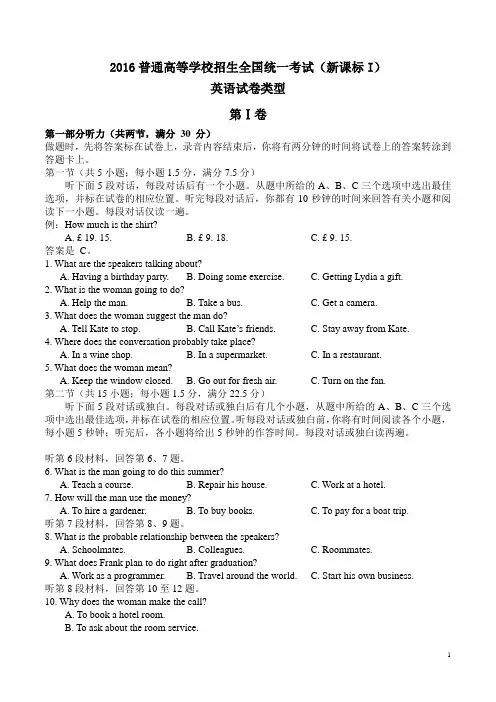
2016普通高等学校招生全国统一考试(新课标I)英语试卷类型第Ⅰ卷第一部分听力(共两节,满分30 分)做题时,先将答案标在试卷上,录音内容结束后,你将有两分钟的时间将试卷上的答案转涂到答题卡上。
第一节(共5小题;每小题1.5分,满分7.5分)听下面5段对话,每段对话后有一个小题。
从题中所给的A、B、C三个选项中选出最佳选项,并标在试卷的相应位置。
听完每段对话后,你都有10秒钟的时间来回答有关小题和阅读下一小题。
每段对话仅读一遍。
例:How much is the shirt?A. £ 19. 15.B. £ 9. 18.C. £ 9. 15.答案是C。
1. What are the speakers talking about?A. Having a birthday party.B. Doing some exercise.C. Getting Lydia a gift.2. What is the woman going to do?A. Help the man.B. Take a bus.C. Get a camera.3. What does the woman suggest the man do?A. Tell Kate to stop.B. Call Kate’s friends.C. Stay away from Kate.4. Where does the conversation probably take place?A. In a wine shop.B. In a supermarket.C. In a restaurant.5. What does the woman mean?A. Keep the window closed.B. Go out for fresh air.C. Turn on the fan.第二节(共15小题;每小题1.5分,满分22.5分)听下面5段对话或独白。
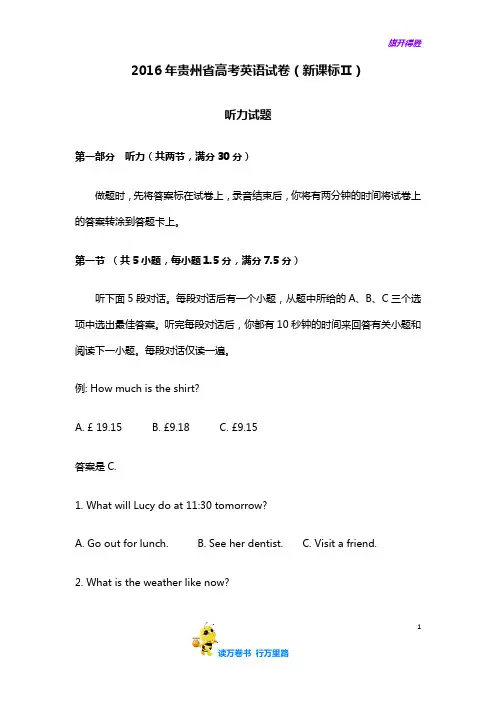
2016年贵州省高考英语试卷(新课标Ⅱ)听力试题第一部分听力(共两节,满分30分)做题时,先将答案标在试卷上,录音结束后,你将有两分钟的时间将试卷上的答案转涂到答题卡上。
第一节(共5小题,每小题1.5分,满分7.5分)听下面5段对话。
每段对话后有一个小题,从题中所给的A、B、C三个选项中选出最佳答案。
听完每段对话后,你都有10秒钟的时间来回答有关小题和阅读下一小题。
每段对话仅读一遍。
例: How much is the shirt?A. £ 19.15B. £9.18C. £9.15答案是C.1. What will Lucy do at 11:30 tomorrow?A. Go out for lunch.B. See her dentist.C. Visit a friend.2. What is the weather like now?1A. It’s sunny.B. It’s rainy.C. It’s cloudy.3. Why does the man talk to Dr. Simpson?A. To make an apology.B. To ask for help.C. To discuss his studies.4. How will the woman get back from the railway station?A. By train.B. By car.C. By bus.5. What does Jenny decide to do first?A. Look for a job.B. Go on a trip.C. Get an assistant.第二节(共15小题;每小题1.5分,满分22.5分)听下面5段对话或独白。
每段对话或独白后有几个小题,从题中所给的A、B、C三个选项中选出最佳选项。
听每段对话或独白前,你将有时间阅读各个小题,每小题5秒钟;听完后,各小题将给出5秒钟的作答时间。
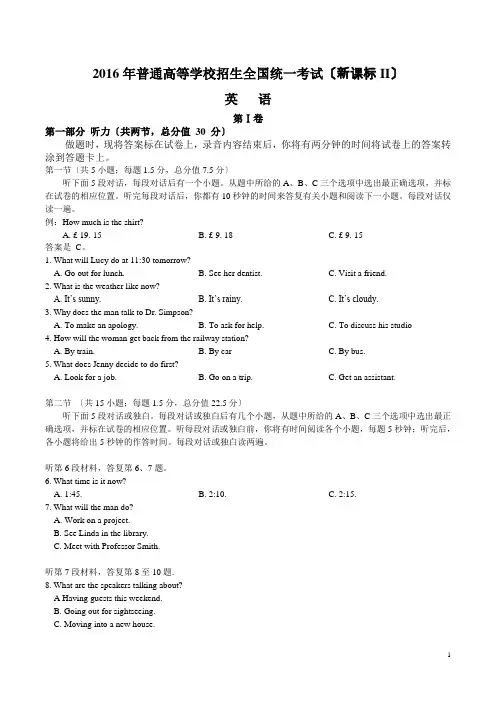
2016年普通高等学校招生全国统一考试〔新课标II〕英语第Ⅰ卷第一部分听力〔共两节,总分值30 分〕做题时,现将答案标在试卷上,录音内容结束后,你将有两分钟的时间将试卷上的答案转涂到答题卡上。
第一节〔共5小题;每题1.5分,总分值7.5分〕听下面5段对话,每段对话后有一个小题。
从题中所给的A、B、C三个选项中选出最正确选项,并标在试卷的相应位置。
听完每段对话后,你都有10秒钟的时间来答复有关小题和阅读下一小题。
每段对话仅读一遍。
例:How much is the shirt?A. £ 19. 15B. £ 9. 18C. £ 9. 15答案是C。
1. What will Lucy do at 11:30 tomorrow?A. Go out for lunch.B. See her dentist.C. Visit a friend.2. What is the weather like now?A. It’s sunny.B. It’s rainy.C. It’s cloudy.3. Why does the man talk to Dr. Simpson?A. To make an apology.B. To ask for help.C. To discuss his studio4. How will the woman get back from the railway station?A. By train.B. By carC. By bus.5. What does Jenny decide to do first?A. Look for a job.B. Go on a trip.C. Get an assistant.第二节〔共15小题;每题1.5分,总分值22.5分〕听下面5段对话或独白。
每段对话或独白后有几个小题,从题中所给的A、B、C三个选项中选出最正确选项,并标在试卷的相应位置。
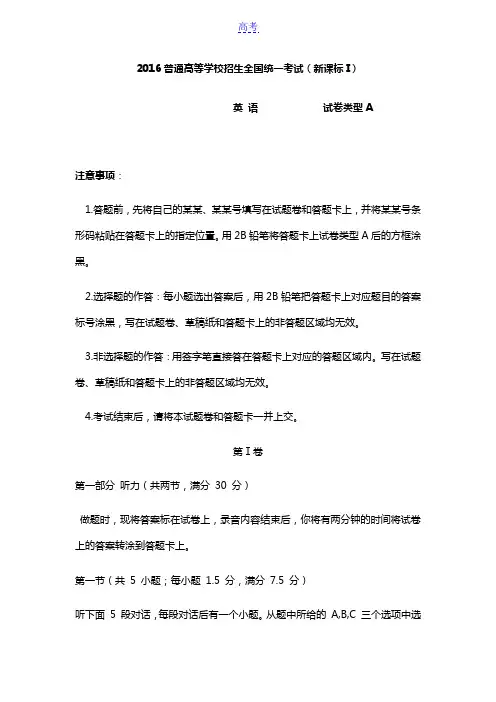
2016普通高等学校招生全国统一考试(新课标I)英语试卷类型A注意事项:1.答题前,先将自己的某某、某某号填写在试题卷和答题卡上,并将某某号条形码粘贴在答题卡上的指定位置。
用2B铅笔将答题卡上试卷类型A后的方框涂黑。
2.选择题的作答:每小题选出答案后,用2B铅笔把答题卡上对应题目的答案标号涂黑,写在试题卷、草稿纸和答题卡上的非答题区域均无效。
3.非选择题的作答:用签字笔直接答在答题卡上对应的答题区域内。
写在试题卷、草稿纸和答题卡上的非答题区域均无效。
4.考试结束后,请将本试题卷和答题卡一并上交。
第Ⅰ卷第一部分听力(共两节,满分30 分)做题时,现将答案标在试卷上,录音内容结束后,你将有两分钟的时间将试卷上的答案转涂到答题卡上。
第一节(共5 小题;每小题1.5 分,满分7.5 分)听下面5 段对话,每段对话后有一个小题。
从题中所给的A,B,C 三个选项中选出最佳选项,并标在试卷的相应位置。
听完每段对话后,你都有10 秒钟的时间来回答有关小题和阅读下一小题。
每段对话仅读一遍。
例:How much is the shirt?A.£ 19.15B.£ 9.18C.£ 9.15答案是C。
1.What are the speakers talking about?A. Having a birthday party.B. Doing some exercise.C. Getting Lydia a gift2.What is the woman going to do?A. Help the man.B. Take a bus.C. Get a camera3.What does the woman suggest the man do?A. Tell Kate to stop.B. Call Kate, s friends.C. Stay away from Kate.4.Where does the conversation probably take place?A. In a wine shop.B. In a supermarket.C. In a restaurant.5.What does the woman mean?A. Keep the window closed.B. Go out for fresh air.C. Turn on the fan.听第6段材料,回答第6、7题。
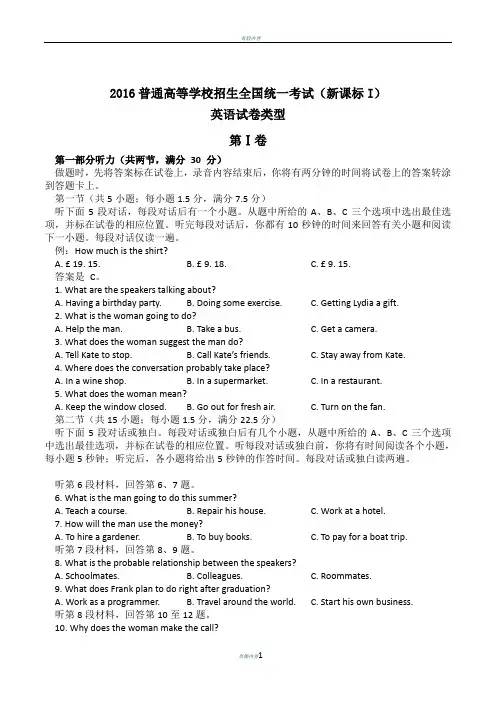
2016普通高等学校招生全国统一考试(新课标I)英语试卷类型第Ⅰ卷第一部分听力(共两节,满分30 分)做题时,先将答案标在试卷上,录音内容结束后,你将有两分钟的时间将试卷上的答案转涂到答题卡上。
第一节(共5小题;每小题1.5分,满分7.5分)听下面5段对话,每段对话后有一个小题。
从题中所给的A、B、C三个选项中选出最佳选项,并标在试卷的相应位置。
听完每段对话后,你都有10秒钟的时间来回答有关小题和阅读下一小题。
每段对话仅读一遍。
例:How much is the shirt?A. £ 19. 15.B. £ 9. 18.C. £ 9. 15.答案是C。
1. What are the speakers talking about?A. Having a birthday party.B. Doing some exercise.C. Getting Lydia a gift.2. What is the woman going to do?A. Help the man.B. Take a bus.C. Get a camera.3. What does the woman suggest the man do?A. Tell Kate to stop.B. Call Kate’s friends.C. Stay away from Kate.4. Where does the conversation probably take place?A. In a wine shop.B. In a supermarket.C. In a restaurant.5. What does the woman mean?A. Keep the window closed.B. Go out for fresh air.C. Turn on the fan.第二节(共15小题;每小题1.5分,满分22.5分)听下面5段对话或独白。
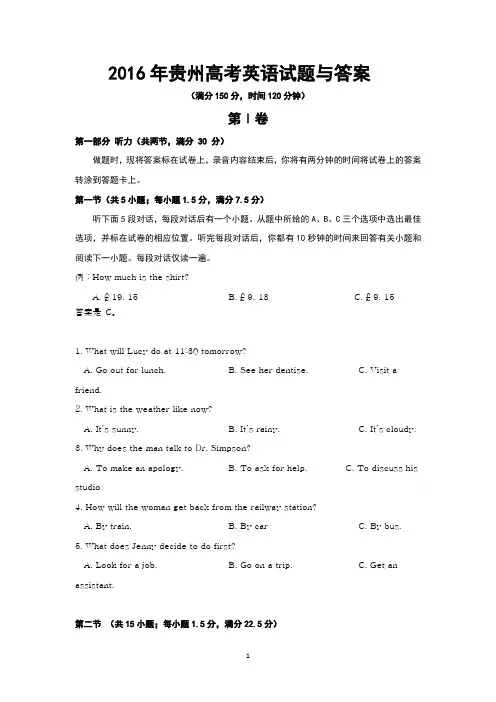
2016年贵州高考英语试题与答案(满分150分,时间120分钟)第Ⅰ卷第一部分听力(共两节,满分 30 分)做题时,现将答案标在试卷上,录音内容结束后,你将有两分钟的时间将试卷上的答案转涂到答题卡上。
第一节(共5小题;每小题1.5分,满分7.5分)听下面5段对话,每段对话后有一个小题。
从题中所给的A、B、C三个选项中选出最佳选项,并标在试卷的相应位置。
听完每段对话后,你都有10秒钟的时间来回答有关小题和阅读下一小题。
每段对话仅读一遍。
例:How much is the shirt?A. £ 19. 15B. £ 9. 18C. £ 9. 15答案是C。
1. What will Lucy do at 11:30 tomorrow?A. Go out for lunch.B. See her dentise.C. Visit a friend.2. What is the weather like now?A. It’s sunny.B. It’s rainy.C. It’s cloudy.3. Why does the man talk to Dr. Simpson?A. To make an apology.B. To ask for help.C. To discuss his studio4. How will the woman get back from the railway station?A. By train.B. By carC. By bus.5. What does Jenny decide to do first?A. Look for a job.B. Go on a trip.C. Get an assistant.第二节(共15小题;每小题1.5分,满分22.5分)听下面5段对话或独白。
每段对话或独白后有几个小题,从题中所给的A、B、C三个选项中选出最佳选项,并标在试卷的相应位置。
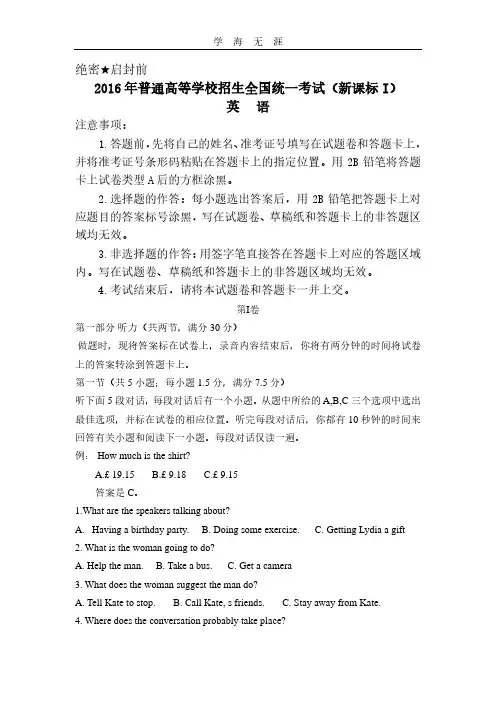
绝密★启封前2016年普通高等学校招生全国统一考试(新课标I)英语注意事项:1.答题前,先将自己的姓名、准考证号填写在试题卷和答题卡上,并将准考证号条形码粘贴在答题卡上的指定位置。
用2B铅笔将答题卡上试卷类型A后的方框涂黑。
2.选择题的作答:每小题选出答案后,用2B铅笔把答题卡上对应题目的答案标号涂黑,写在试题卷、草稿纸和答题卡上的非答题区域均无效。
3.非选择题的作答:用签字笔直接答在答题卡上对应的答题区域内。
写在试题卷、草稿纸和答题卡上的非答题区域均无效。
4.考试结束后,请将本试题卷和答题卡一并上交。
第Ⅰ卷第一部分听力(共两节,满分 30 分)做题时,现将答案标在试卷上,录音内容结束后,你将有两分钟的时间将试卷上的答案转涂到答题卡上。
第一节(共 5 小题;每小题 1.5 分,满分 7.5 分)听下面 5 段对话,每段对话后有一个小题。
从题中所给的 A,B,C 三个选项中选出最佳选项,并标在试卷的相应位置。
听完每段对话后,你都有 10 秒钟的时间来回答有关小题和阅读下一小题。
每段对话仅读一遍。
例: How much is the shirt?A.£ 19.15B.£ 9.18C.£ 9.15答案是 C。
1.What are the speakers talking about?A. Having a birthday party.B. Doing some exercise.C. Getting Lydia a gift2. What is the woman going to do?A. Help the man.B. Take a bus.C. Get a camera3. What does the woman suggest the man do?A. Tell Kate to stop.B. Call Kate, s friends.C. Stay away from Kate.4. Where does the conversation probably take place?A. In a wine shop.B. In a supermarket.C. In a restaurant.5. What does the woman mean?A. Keep the window closed.B. Go out for fresh air.C. Turn on the fan.听第6段材料,回答第6、7题。
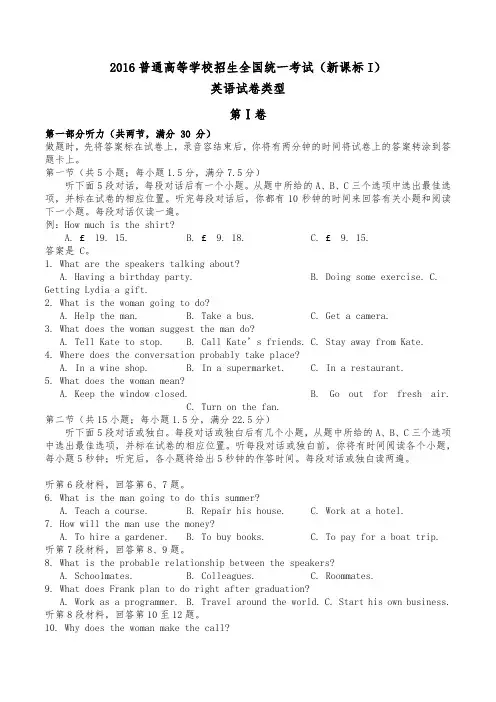
2016普通高等学校招生全国统一考试(新课标I)英语试卷类型第Ⅰ卷第一部分听力(共两节,满分 30 分)做题时,先将答案标在试卷上,录音容结束后,你将有两分钟的时间将试卷上的答案转涂到答题卡上。
第一节(共5小题;每小题1.5分,满分7.5分)听下面5段对话,每段对话后有一个小题。
从题中所给的A、B、C三个选项中选出最佳选项,并标在试卷的相应位置。
听完每段对话后,你都有10秒钟的时间来回答有关小题和阅读下一小题。
每段对话仅读一遍。
例:How much is the shirt?A. £ 19. 15.B. £ 9. 18.C. £ 9. 15.答案是 C。
1. What are the speakers talking about?A. Having a birthday party.B. Doing some exercise.C. Getting Lydia a gift.2. What is the woman going to do?A. Help the man.B. Take a bus.C. Get a camera.3. What does the woman suggest the man do?A. Tell Kate to stop.B. Call Kate’s friends.C. Stay away from Kate.4. Where does the conversation probably take place?A. In a wine shop.B. In a supermarket.C. In a restaurant.5. What does the woman mean?A. Keep the window closed.B. Go out for fresh air.C. Turn on the fan.第二节(共15小题;每小题1.5分,满分22.5分)听下面5段对话或独白。
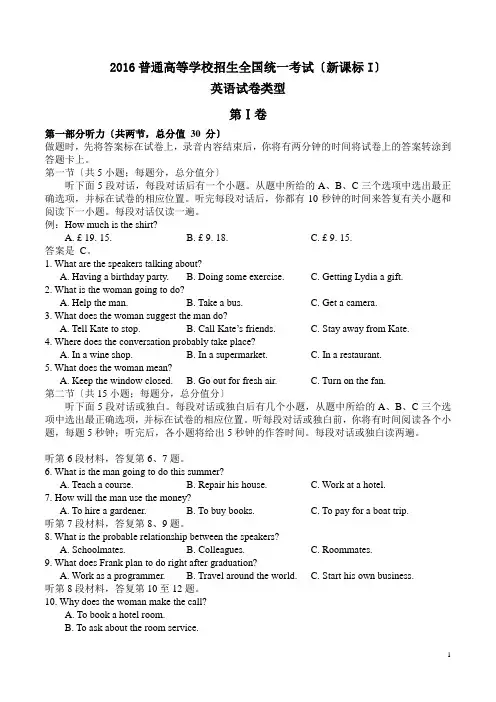
2016普通高等学校招生全国统一考试〔新课标I〕英语试卷类型第Ⅰ卷第一部分听力〔共两节,总分值30 分〕做题时,先将答案标在试卷上,录音内容结束后,你将有两分钟的时间将试卷上的答案转涂到答题卡上。
第一节〔共5小题;每题分,总分值分〕听下面5段对话,每段对话后有一个小题。
从题中所给的A、B、C三个选项中选出最正确选项,并标在试卷的相应位置。
听完每段对话后,你都有10秒钟的时间来答复有关小题和阅读下一小题。
每段对话仅读一遍。
例:How much is the shirt?A. £ 19. 15.B. £ 9. 18.C. £ 9. 15.答案是C。
1. What are the speakers talking about?A. Having a birthday party.B. Doing some exercise.C. Getting Lydia a gift.2. What is the woman going to do?A. Help the man.B. Take a bus.C. Get a camera.3. What does the woman suggest the man do?A. Tell Kate to stop.B. Call Kate’s friends.C. Stay away from Kate.4. Where does the conversation probably take place?A. In a wine shop.B. In a supermarket.C. In a restaurant.5. What does the woman mean?A. Keep the window closed.B. Go out for fresh air.C. Turn on the fan.第二节〔共15小题;每题分,总分值分〕听下面5段对话或独白。
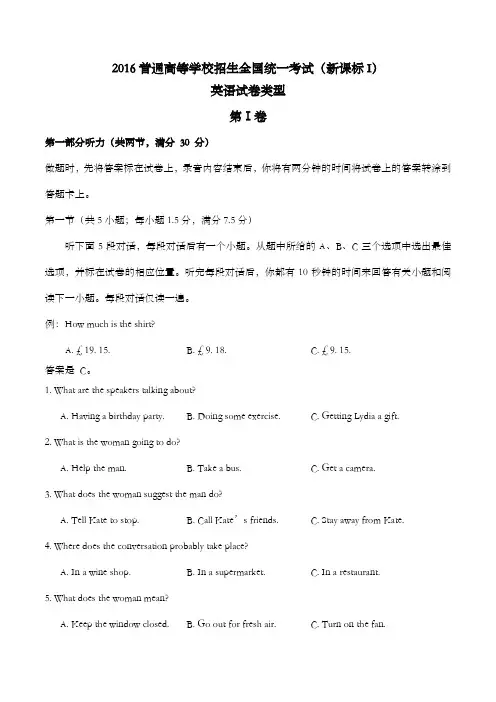
2016普通高等学校招生全国统一考试(新课标I)英语试卷类型第Ⅰ卷第一部分听力(共两节,满分30 分)做题时,先将答案标在试卷上,录音内容结束后,你将有两分钟的时间将试卷上的答案转涂到答题卡上。
第一节(共5小题;每小题1.5分,满分7.5分)听下面5段对话,每段对话后有一个小题。
从题中所给的A、B、C三个选项中选出最佳选项,并标在试卷的相应位置。
听完每段对话后,你都有10秒钟的时间来回答有关小题和阅读下一小题。
每段对话仅读一遍。
例:How much is the shirt?A. £ 19. 15.B. £ 9. 18.C. £ 9. 15.答案是C。
1. What are the speakers talking about?A. Having a birthday party.B. Doing some exercise.C. Getting Lydia a gift.2. What is the woman going to do?A. Help the man.B. Take a bus.C. Get a camera.3. What does the woman suggest the man do?A. Tell Kate to stop.B. Call Kate’s friends.C. Stay away from Kate.4. Where does the conversation probably take place?A. In a wine shop.B. In a supermarket.C. In a restaurant.5. What does the woman mean?A. Keep the window closed.B. Go out for fresh air.C. Turn on the fan.第二节(共15小题;每小题1.5分,满分22.5分)听下面5段对话或独白。

2016高考英语全国卷试题及答案官方版绝密★启封前注意事项:1.答题前,先将自己的姓名、准考证号填写在试题卷和答题卡上,并将准考证号条形码粘贴在答题卡上的指定位置。
用2B铅笔将答题卡上试卷类型A后的方框涂黑。
2.选择题的作答:每小题选出答案后,用2B铅笔把答题卡上对应题目的答案标号涂黑,写在试题卷、草稿纸和答题卡上的非答题区域均无效。
3.非选择题的作答:用签字笔直接答在答题卡上对应的答题区域内。
写在试题卷、草稿纸和答题卡上的非答题区域均无效。
4.考试结束后,请将本试题卷和答题卡一并上交。
第Ⅰ卷第一部分听力(共两节,满分30 分)做题时,现将答案标在试卷上,录音内容结束后,你将有两分钟的时间将试卷上的答案转涂到答题卡上。
第一节(共5 小题;每小题 1.5 分,满分7.5 分)听下面5 段对话,每段对话后有一个小题。
从题中所给的A,B,C 三个选项中选出最佳选项,并标在试卷的相应位置。
听完每段对话后,你都有10 秒钟的时间来回答有关小题和阅读下一小题。
每段对话仅读一遍。
例:How much is the shirt?A.£ 19.15B.£ 9.18C.£ 9.15答案是C。
1.What are the speakers talking about?A. Having a birthday party.B. Doing some exercise.C. Getting Lydia a gift2.What is the woman going to do?A. Help the man.B. Take a bus.C. Get a camera3.What does the woman suggest the man do?A. Tell Kate to stop.B. Call Kate, s friends.C. Stay away from Kate.4.Where does the conversation probably take place?A. In a wine shop.B. In a supermarket.C. In a restaurant.5.What does the woman mean?A. Keep the window closed.B. Go out for fresh air.C. Turn on the fan.听第6段材料,回答第6、7题。
绝密★启用前2016贵州高考英语真题及答案注意事项:本试卷分第I卷(选择题)和第II卷(非选择题)两部分。
考试结束后.将本试卷和答题卡一并交回。
第I卷注意事项:1.答第I卷前,考考生务必将自己的姓名、考生号填写在答题卡上。
2.选出每小题答案后,用铅笔把答题卡上对应的题目的答案标号涂黑。
如需改动,用橡皮擦干净后,在选涂其他答案标号。
不能答在本试卷,否则无效。
第一部分阅读理解(共两节,满分40分)第一节(共15小题;每小题2分,满分30分)阅读下列短文,从每题所给的四个选项(A、B、C和D)中,选出最佳选项,并在答题卡上将该项涂黑。
AMusicOpera at Music Hall: 1243 Elm Street. The season runs June through August, with additional performances in March and September. The Opera honors Enjoy the Arts membership discounts. Phone: 241-2742.Chamber Orchestra: The Orchestra plays at Memorial Hall at 1406 Elm Street, which offers several concerts from March through June. Call 723-1182 for more information. . Symphony Orchestra: At Music Hall and Riverbend. For ticket sales, call 381-3300. Regular season runs September through May at Music Hall in summer at Riverbend.College Conservatory of Music (CCM): Performances are on the main campus(校园) of the university, usually at Patricia Cobbett Theater. CCM organizes a variety of events, including performances by the well-known LaSalle Quartet, CCM’s Philharmonic Orchestra, and various groups of musicians presenting Baroque through modern music. Students with I.D. cards can attend the events for free.A free schedule of events for each term is available by calling the box office at 556-4183. Riverbend Music Theater: 6295 Kellogg Ave. Large outdoor theater with the closest seats under cover (price difference).Big name shows all summer long! Phone:232-6220.1. Which number should you call if you want to see an opera?A. 241-2742.B. 723-1182.C. 381-3300.D. 232-6220.2. When can you go to a concert by Chamber Orchestra?A. February.B. May.C. August.D. November.3.Where can students go for free performances with their I.D. cards?A. Music Hall.B. Memorial Hall.C. Patricia Cobbett Theater.D. Riverbend Music Theater.4. How is Riverbend Music Theater different from the other places?A. It has seats in the open air.B. It gives shows all year round.C. It offers membership discounts.D. It presents famous musical works.BOn one of her trips to New York several years ago, Eudora Welty decided to take a couple of New York friends out to dinner. They settled in at a comfortable East Side cafe and within minutes, another customer was approaching their table.“Hey, aren’t you from Mississippi?”the elegant, white-haired writer remembered being asked by the stranger. “I’m from Mississippi too.”Without a second thought, the woman joined the Welty party. When her dinner partner showed up, she also pulled up a chair.“They began telling me all the news of Mississippi,” Welty said. “I didn’t know what my New York friends were thinking.”Taxis on a rainy New York night are rarer than sunshine. By the time the group got up to leave, it was pouring outside. Welty’s new friends immediately sent a waiter to find a cab. Heading back downtown toward her hotel, her big-city friends were amazed at the turn of events that had changed their Big Apple dinner into a Mississippi.“My friends said: ‘Now we believe your stories,’” Welty added. “And I said: ‘Now you know. These are the people that make me write them.’”Sitting on a sofa in her room, Welty, a slim figure in a simple gray dress, looked pleased with this explanation.“I don’t make them up,”she said of the characters in her fiction these last 50 or so years. “I don’t have to.”Beauticians, bartenders, piano players and people with purple hats, Welty’s people come from afternoons spent visiting with old friends, from walks through the streets of her native Jackson, Miss., from conversations overheard on a bus. It annoys Welty that, at 78, her left ear has now given out. Sometimes, sitting on a bus or a train, she hears only a fragment(片段) of a particularly interesting story.5. What happened when Welty was with her friends at the cafe?A. Two strangers joined her.B. Her childhood friends came in.C. A heavy rain ruined the dinner.D. Some people held a party there.6. The underlined word “them” in Paragraph 6 refers to Welty’s .A. readersB. partiesC. friendsD. stories7. What can we learn about the characters in Welty’s fiction?A. They live in big cities.B. They are mostly women.C. They come from real life.D. They are pleasure seekers.CIf you are a fruit grower—or would like to become one—take advantage of Apple Day to see what’s around. It’s called Apple Day but in practice it’s more like Apple Month. The day itself is on October 21, but since it has caught on, events now spread out over most of October around Britain.Visiting an apple event is a good chance to see, and often taste, a wide variety of apples. To people who are used to the limited choice of apples such as Golden Delicious and Royal Gala in supermarkets, it can be quite an eye opener to see the range of classical apples still in existence, such as Decio which was grown by the Romans. Although it doesn’t taste of anything special, it’s still worth a try, as is the knobbly(多疙瘩的) Cat’s Head which is more of a curiosity than anything else.There are also varieties developed to suit specific local conditions. One of the very best varieties for eating quality is Orleans Reinette, but you’ll need a warm, sheltered place with perfect soil to grow it, so it’s a pipe dream for most apple lovers who fall for it.At the events, you can meet expert growers and discuss which ones will best suit your conditions, and because these are family affairs, children are well catered for with apple-themed fun and games.Apple Days are being held at all sorts of places with an interest in fruit, including stately gardens and commercial orchards(果园).If you want to have a real orchard experience, try visiting the National Fruit Collection at Brogdale, near Faversham in Kent.8.What can people do at the apple events?A. Attend experts’ lectures.B. Visit fruit-loving families.C. Plant fruit trees in an orchard.D. Taste many kinds of apples.9.What can we learn about Decio?A. It is a new variety.B. It has a strange look.C. It is rarely seen now.D. It has a special taste.10. What does the underlined phrase “a pipe dream” in Paragraph 3mean?A. A practical idea.B. A vain hope.C.A brilliant plan.D. A selfish desire.11.What is the author’s p urpose in writing the text?A. To show how to grow apples.B .To introduce an apple festival.C. To help people select apples.D. To promote apple research.DBad news sells. If it bleeds, it leads. No news is good news, and good news is no news. Those are the classic rules for the evening broadcasts and the morning papers. But now that information is being spread and monitored(监控) in different ways, researchers are discovering new rules. By tracking people’s e-mails and online posts, scientists have found that good news can spread faster and farther than disasters and sob stories.“The ‘if it bleeds’ rule works for mass media,” says Jon ah Berger, a scholar at theUniversity of Pennsylvania. “They want your eyeballs and don’t care how you’re feeling. But when you share a story with your friends, you care a lot more how they react. You don’t want them to think of you as a Debbie Downer.”Researchers analyzing word-of-mouth communication—e-mails, Web posts and reviews, face-to-face conversations—found that it tended to be more positive than negative(消极的), but that didn’t necessarily mean people preferred positive news. Was positive news s hared more often simply because people experienced more good things than bad things? To test for that possibility, Dr. Berger looked at how people spread a particular set of news stories: thousands of articles on The New York Times’ website. He and a Penn colleague analyzed the “most e-mailed” list for six months. One of his first findings was that articles in the science section were much more likely to make the list than non-science articles. He found that science amazed Times’ readers and made them want to share this positive feeling with others.Readers also tended to share articles that were exciting or funny, or that inspired negative feelings like anger or anxiety, but not articles that left them merely sad. They needed to be aroused(激发) one way or the other, and they preferred good news to bad. The more positive an article, the more likely it was to be shared, as Dr. Berger explains in his new book, “Contagious: Why Things Catch On.”12 .What do the classic rules mentioned in the text apply to?A. News reports.B. Research papers.C .Private e-mails. D. Daily conversations.13. What can we infer about people like Debbie Downer?A. They’re socially inactive.B. They’re good at telling stories.C. They’re inconsiderate of others.D. They’re careful with their words.14.Which tended to be the most e-mailed according to Dr. Berger’s research?A . Sports new. B. Science articles.C. Personal accounts.D. Financial reviews.15 .What can be a suitable title for the text?A. Sad Stories Travel Far and WideB .Online News Attracts More PeopleC. Reading Habits Change with the TimesD. Good News Beats Bad on Social Networks第二节 (共5小题;每小题2分,满分10分)根据短文内容,从短文后的选项中选出能填入空白处的最佳选项。
2016年普通高等学校招生全国统一考试英语第Ⅰ卷第一部分听力(共两节,满分30 分)第一节(共5小题;每小题1.5分,满分7.5分)听下面5段对话,每段对话后有一个小题。
从题中所给的A、B、C三个选项中选出最佳选项,并标在试卷的相应位置。
听完每段对话后,你都有10秒钟的时间来回答有关小题和阅读下一小题。
每段对话仅读一遍。
例:How much is the shirt?A. £ 19. 15B. £ 9. 18C. £ 9. 15答案是C。
1. What will Lucy do at 11:30 tomorrow?A. Go out for lunch.B. See her dentist.C. Visit a friend.2. What is the weather like now?A. It’s sunny.B. It’s rainy.C. It’s cloudy.3. Why does the man talk to Dr. Simpson?A. To make an apology.B. To ask for help.C. To discuss his studies.4. How will the woman get back from the railway station?A. By train.B. By car.C. By bus.5. What does Jenny decide to do first?A. Look for a job.B. Go on a trip.C. Get an assistant.第二节(共15小题;每小题1.5分,满分22.5分)听下面5段对话或独白。
每段对话或独白后有几个小题,从题中所给的A、B、C三个选项中选出最佳选项,并标在试卷的相应位置。
听每段对话或独白前,你将有时间阅读各个小题,每小题5秒钟;听完后,各小题将给出5秒钟的作答时间。
2016高等学校招生全国统一考试本试卷共16页,共150分。
考试时间为120分钟。
考生务必将答案答在答题卡上,在试卷上作答无效。
考试结束后,将本试卷和答题卡一并交回。
第一部分:听力理解(共三节:30 分)第一节(共 5 小题;每小题分,共分)听下面5段对话。
每段对话后有一道小题,从每题所给的A、B、C三个选项中选出最佳选项。
听完每段对话后,你将有10秒钟的时间来回答有关小题和阅读下一小题,每段对话你将听一遍。
例:What is the man going to read?A.A newspaperB.A magazineC.A book答案是A1.What kind of music does the woman like?A.Classical music B. Rock music C. Country music2. Which sweater will the man take?A.The red one B。
The blue one C. The yellow onewill the man pay?A.In cash B. By credit card C. By traveler’s cheque4. Where are the woman’s keys?A. In her pocketB. On the floorC. On the table5. What will the man probably do tonight?A. Read Chapter 4B. Study in the libraryC. Watch the football match第二节(共10小题;每小题分,共15分)听下面4段对话或独白。
每段对话或独白后有几道小题,从每题所给的A、B、C 三个选项中选出最佳选项。
听每段对话或独白前,你将有5秒钟的时间阅读每小题。
听完后,每小题将给出5秒钟的作答时间。
每段对话或独白你将听两遍。
2016贵州高考英语听力篇一:2016年9月PETS全国公共英语等级考试二级听力试题(即:2016年9月贵州省高考英语听力考试)2016年9月PETS全国公共英语等级考试二级听力试题(即:2016年9月10日贵州省高考英语听力考试真题)贵州省凯里一中刘治豪编辑整理20160912版权所有,盗用必究第一节听下面5段对话,每段对话后有一个小题,从题中所给的A、B、C三个选项中选出最佳选项,并标在试卷的相应位置。
听完每段对话后,你都有10秒钟的时间来回答有关小题和阅读下一小题。
每段对话仅读一遍。
1. What does the woman mean?A. She is going out next week.B. She needs the car for her family.C. She invites the man to an outing.2. How does Jack feel these days?A. Excited.B. Worried.C. T ouched.3. What is the relationship between the speakers?A. Mother and son.B. Doctor and patient.C. T eacher and student.4. What will the speakers probably do this weekend?A. See a movie.B. Buy a refrigerator.C. Eat out in town.5. When will the next train for Chicago leave?A. At 08:30.B. At 10:30.C. At 11:30.第二节听下面5段对话或独白。
每段对话或独白后有2至4个小题,从题中所给的A、B、C三个选项中选出最佳选项,并标在试卷的相应位置。
听每段对话或独白前,你将有5秒钟的时间阅读各个小题;听完后,各小题将给出5秒钟的作答时间,每段对话或独白读两遍。
2016年贵州省高考英语试题及答案第Ⅰ卷第一部分听力(共两节,满分30 分)做题时,现将答案标在试卷上,录音内容结束后,你将有两分钟的时间将试卷上的答案转涂到答题卡上。
第一节(共5小题;每小题1.5分,满分7.5分)听下面5段对话,每段对话后有一个小题。
从题中所给的A、B、C三个选项中选出最佳选项,并标在试卷的相应位置。
听完每段对话后,你都有10秒钟的时间来回答有关小题和阅读下一小题。
每段对话仅读一遍。
例:How much is the shirt?A. £ 19. 15B. £ 9. 18C. £ 9. 15答案是C。
1. What will Lucy do at 11:30 tomorrow?A. Go out for lunch.B. See her dentise.C. Visit a friend.2. What is the weather like now?A. It’s sunny.B. It’s rainy.C. It’s cloudy.3. Why does the man talk to Dr. Simpson?A. To make an apology.B. To ask for help.C. To discuss his studio4. How will the woman get back from the railway station?A. By train.B. By carC. By bus.5. What does Jenny decide to do first?A. Look for a job.B. Go on a trip.C. Get an assistant.第二节(共15小题;每小题1.5分,满分22.5分)听下面5段对话或独白。
每段对话或独白后有几个小题,从题中所给的A、B、C三个选项中选出最佳选项,并标在试卷的相应位置。
听每段对话或独白前,你将有时间阅读各个小题,每小题5秒钟;听完后,各小题将给出5秒钟的作答时间。
每段对话或独白读两遍。
听第6段材料,回答第6、7题。
6. What time is it now?A. 1:45.B. 2:10.C. 2:15.7. What will the man do?A. Work on a project.B. See Linda in the library.C. Meet with Professor Smith.听第7段材料,回答第8至10题.8. What are the speakers talking about?A Having guests this weekend.B. Going out for sightseeing.C. Moving into a new house.9. What is the relationship between the speakers?A. Neighbors.B. Husband and wife.C. Host and visitor.10. What will the man do tomorrow?A. Work in his garden.B. Have a barbecue.C. Do some shopping.听第8段材料,回答第11至13题.11. Where was the man born?A. In Philadelphia.B. In Springfield.C. In Kansas.12. What did the man like doing when he was a child?A. Drawing.B. Traveling.C. Reading.13. What inspires the man most in his work?A. Education.B. Family love.C. Nature.听第9段材料,回答第14至17题.14. Why is Dorothy going to Europe?A. To attend a training program.B. To carry out some research.C. To take a vacation.15. How long will Dorothy stay in Europe'/A. A few days.B. Two weeks.C. Three months.16. What does Dorothy think of her apartment?A. It’s expensive.B. It’s satisfactory.C. It's inconvenient.17 What docs Bill offer to do for Dorothy?A. Recommend her apartment to Jim.B. a new apartment for her.C. Take care of her apartment.听第10段材料,回答第18至20题.18. What are the tourists advised to do when touring London?A. Take their tour scheduleB. Watch out for the trC. Wear comfortable shoe.19. What will the tourists do in fifteen minutes?A. Meet the speaker.B. Go to their rooms.C. Change some money.20. Where probably is the speaker?A. In a park.B. In a hotel.C. In a shopping centre.第二部分阅读理解(共两节,满分40分)第一节(共15题:每小题2分,满分30分)阅读下列短文,从每题所给的四个选项(A、B、C和D)中,选出最佳选项,并在答题卡上将该项涂黑。
AWhat’s on?Electric Underground7.30pm-1.00am Free at the Cyclops TheatreDo you know who’s playing in your area? We’re bringing you an evening of live rock and pop music from the best local bands. Are you interested in becoming a musician and getting a recording contract(合同)? If so, come early to the talk at 7.30pm by Jules Skye, a successful record producer. He’s going to talk about how you can find the right person to produce you music.Gee Whizz8.30pm-10.30pm Comedy at KaleidoscopeCome and see Gee Whizz perform. He’s the funniest stand-up comedian on the comedy scene. This joyful show will please everyone, from the youngest to the oldest. Gee Whizz really knows how to make you laugh! Our bar is open from 7.00pm for drinks and snacks(快餐).Simon’s Workshop5.00pm-7.30pm Wednesdays at Victoria StageThis is a good chance for anyone who wants to learn how to do comedy. The workshop looks at every kind of comedy, and practices many different ways of making people laugh. Simon is a come dian and actor who has 10 years’ experience of teaching comedy. His workshops are exciting and fun. An evening with Simon will give you the confidence to be funny.Charlotte Stone8.00pm-11.00pm Pizza WorldFine food with beautiful jazz music; this is a great evening out. Charlotte Stone will perform songs from her new best-selling CD, with James Pickering on the piano. The menu is Italian, with excellent meat and fresh fish, pizzas and pasta(面食). Book early to get a table. Our bar is open all day, and serves cocktails, coffee, beer, and white wine.21. Who can help you if you want to have your music produced?A. Jules Skye.B. Gee Whizz.C. Charlotte Stone.D. James Pickering.22. At which place can people of different ages enjoy a good laugh?A. The Cyclops TheatreB. KaleidoscopeC. Victoria StageD. Pizza World23. What do we know about Simon’s Workshop?A. It requires membership status.B. It lasts three hours each time.C. It is run by a comedy club.D. It is held every Wednesday.24. When will Charlotte Stone perform her songs?A. 5.00pm-7.30pm.B. 7.30pm-1.00am.C. 8.00pm-11.00pm.D. 8.30pm-10.30pm.BFive years ago, when I taught art at a school in Seattle, I used Tinkertoys as a test at the beginning of a term to find out something about my students. I put a small set of Tinkertoys in front of each student, and said:”Make something out of the Tinkertoys. You have 45 minutes today - and 45minutes each day for the rest of the week.”A few students hesitated to start. They waited to see the rest of the class would do. Several others checked the instructions and made something according to one of the model plans provided. Another group built something out of their own imaginations.Once I had a boy who worked experimentally with Tinkertoys in his free time. His constructions filled a shelf in the art classroom and a good part of his bedroom at home. I was delighted at the presence of such a student. Here was an exceptionally creative mind at work. His presence meant that I had an unexpected teaching assistant in class whose creativity wouldinfect(感染) other students.Encouraging this kind of thinking has a downside. I ran the risk of losing those students who had a different style of thinking. Without fail one would declare,” But I’m just not creative.”“Do you dream at night when you’re asleep?”“Oh, sure.”“So tell me one of your most interesting dreams.” The student would tell something wildly imaginative. Flying in the sky or in a time machine or growing three heads. “That’s pretty creative. Who does that for you?”“Nobody. I do it.”“Really-at night, when you’re asleep?”“Sure.”“Try doing it in the daytime, in class, okay?”25. The teacher used Tinkertoys in class in order to ________?A. know more about the studentsB. make the lessons more excitingC. raise the stude nts’ interest in artD. teach the students about toy design26. What do we know about the boy mentioned in Paragraph 3?A. He liked to help his teacher.B. He preferred to study alone.C. He was active in class.D. He was imaginative.27. What d oes the underlined word “downside” in Paragraph 4 probably mean?A. Mistake.B. Drawback.C. Difficulty.D. Burden.28. Why did the teacher ask the students to talk about their dreams?A. To help them to see their creativity.B. To find out about their sleeping habits.C. To help them to improve their memory.D. To find out about their ways of thinking.CReading can be a social activity. Think of the people who belong to book groups. They choose books to read and then meet to discuss them. Now, the website turns the page on the traditional idea of a book group.Members go on the site and register the books they own and would like to share. BookCrossing provides an identification number to stick inside the book. Then the person leaves it in a public place, hoping that the book will have an adventure, traveling far and wide with each new reader who finds it.Bruce Pederson, the managing director of BookCrossing, says, “The two things that change your life are the people you meet and books you read. BookCrossing combines both.”Members leave books on park benches and buses, in train stations and coffee shops. Whoever finds their book will go to the site and record where they found it.People who find a book can also leave a journal entry describing what they thought of it.E-mails are then sent to the BookCrossing to keep them updated about where their books have been found. Bruce peterson says the idea is for people not to be selfish by keeping a book to gather dust on a shelf at home.BookCrossing is part of a trend among people who want to get back to the “real” and not the virtual(虚拟). The site now has more than one million members in more than one hundredthirty-five countries.29. Why does the author mention book groups in the first paragraph?A. To explain what they are.B. To introduce BookCrossing.C. To stress the importance of reading.D. To encourage readers to share their ideas.30. What does the underlined word “it” in Paragraph 2refer to?A. The book.B. An adventure.C. A public place.D. The identification number.31. What will a BookCrosser do with a book after reading it?A. Meet other readers to discuss it.B. Keep it safe in his bookcase.C. Pass it on to another reader.D. Mail it back to its owner.32. What is the best title for the text?A. Online Reading: A Virtual TourB. Electronic Books: A new TrendC. A Book Group Brings Tradition BackD. A Website Links People through BooksDA new collection of photos brings an unsuccessful Antarctic voyage back to life.Frank Hurley’s pictures would be outstanding----undoubtedly first-rate photo-journalism---if they had been made last week. In fact, they were shot from 1914 through 1916, most of them after a disastrous shipwreck(海滩), by a cameraman who had no reasonable expectation of survival.Many of the images were stored in an ice chest, under freezing water, in the damaged wooden ship.The ship was the Endurance, a small, tight, Norwegian-built three-master that was intended to take Sir Ernest Shackleton and a small crew of seamen and scientists, 27 men in all, to the southernmost shore of Antarctica’s Weddell Sea. From that point Shackleton wanted to force a passage by dog sled(雪橇) across the continent. The journey was intended to achieve more than what Captain Robert Falcon Scott had done. Captain Scott had reached the South Pole early in 1912 but had died with his four companions on the march back.As writer Caroline Alexander makes clear in her forceful and well-researched story The Endurance, adventuring was even then a thoroughly commercial effort. Scott’s last journey, completed as be lay in a tent dying of cold and hunger, caught the world’s imagination, and a film made in his honor drew crowds. Shackleton, a onetime British merchant-navy officer who had got to within 100 miles of the South Pole in 1908, started a business before his 1914 voyage to make money from movie and still photography. Frank Hurley, a confident and gifted Australian photographer who knew the Antarctic, was hired to make the images, most of which have never before been published.33. What do we know about the photos taken by Hurley?A. They were made last weekB. They showed undersea sceneriesC. They were found by a cameramanD. They recorded a disastrous adventure34. Who reached the South Pole first according to the text?A. Frank HurleyB. Ernest ShackletonC. Robert Falcon ScottD. Caroline Alexander35. What does Alexander think was the purpose of the 1914 voyage?A. Artistic creationB. Scientific researchC. Money makingD. Treasure hunting第二节(共5小题;每小题2分,满分10分)根据短文内容,从短文后的选项中选出能填入空白处的最佳选项。